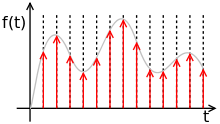Discrete-time signal

A discrete signal or discrete-time signal is a time series consisting of a sequence of quantities. In other words, it is a time series that is a function over a domain of integers.
Unlike a continuous-time signal, a discrete-time signal is not a function of a continuous argument; however, it may have been obtained by sampling from a continuous-time signal, and then each value in the sequence is called a sample. When a discrete-time signal obtained by sampling a sequence corresponds to uniformly spaced times, it has an associated sampling rate; the sampling rate is not apparent in the data sequence, and so needs to be associated as a characteristic unit of the system.
Acquisition
Discrete-time signals may have several origins, but can usually be classified into one of two groups:[1]
- By acquiring values of an analog signal at constant or variable rate. This process is called sampling.[2]
- By observing an inherently discrete-time process, such as the weekly peak value of a particular economic indicator.
See also
References
- Gershenfeld, Neil A. (1999). The Nature of mathematical Modeling. Cambridge University Press. ISBN 0-521-57095-6.
- Wagner, Thomas Charles Gordon (1959). Analytical transients. Wiley.